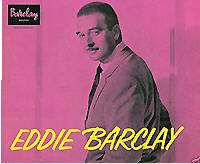
Eddie Barclay
| The Bandit |
Born Edouard Ruault the son of a café waiter and a post office worker in Paris on January 26, 1921, he spent much of his early childhood with his grandmother in Taverny (in today's Val-d'Oise). His parents bought the Café de la Poste bar in the middle of Paris while he was a child and at the age of 15 he left school to work in the café. He had not enjoyed his studies but he taught himself music and piano. He particularly liked American jazz and embraced the music of Fats Waller. He often visited the Hot Club de France to hear the quintet of Stéphane Grappelli and Django Reinhardt.He became a pianist at L'Étape club in rue Godot-de-Maury, Paris where his half-hour sets alternated with the young Louis de Funès, also at the start of his career. When the German occupiers of France banned jazz, he held regular social gatherings with other zazous at his home to listen to jazz records, and illegal radio stations. Pierre-Louis Guérin employed him as a pianist at Guérin's first nightclub, Le Club.
With the liberation in 1944 and consequent fashion for American music, Ruault changed his name to Eddie Barclay. Under this new name he married Michèle, the first of his nine wives, in 1945. His friends included Boris Vian, Henri Salvador, and Michel Legrand. He launched what he claimed to be the first discothèque, Eddie's Club, based on the American clubs that had opened to serve US military personnel, and started his own band in 1947. The band included Harry Cooper (trumpet), Jean-Pierre Sasson (electric guitar), Bobby Guidott (bass), and Eve Williams (vocals). Eve, whose real name was Nicole, would become his second wife. The band were to accompany Louis Armstrong, Ella Fitzgerald, Dizzy Gillespie, Sacha Distel, and Quincy Jones, who became the artistic director of Barclay Records at the end of the 1950s. It was during this time that he met Charles Aznavour.
In 1949, with the help of Nicole, Barclay established Blue Star, his first record label, selling 78 rpm discs. The couple used their flat as a warehouse and used his scooter to make deliveries. Early records on the label were by Renée Lebas, Eddie Constantine and Don Byas. Nicole also helped him to found Jazz Magazine in 1954 with Boris Vian as the editor.
In 1952 Alan Morrison, a visitor to Barclay's club, had invited him to visit the US to see the new recording technology that enabled the production of 45s and LPs. In 1955 Barclay agreed to manufacture and distribute Mercury Records in Europe. He took 60 masters to Pathé-Marconi's Paris factory and began promoting the new microgroove format to the French market. As well as releasing US records by the likes of Ray Charles, Dizzy Gillespie, Sammy Davis, Jr. and Duke Ellington, Barclay engaged Gerhard Lehner, a German sound engineer, to make original recordings in rue Hoche, Paris. After selling 1.5 million copies of The Platters' Only You, Barclay Records rose to become the top music production company in France. His success led to his nickname as "roi du microsillon" (king of microgroove).
His Francophone discoveries included the singers Hugues Aufray, Michel Delpech, Dalida (whom he launched in 1956), Mireille Mathieu, Claude Nougaro, and Eddy Mitchell. His artistes delighted in the artistic freedom that he afforded them, and in the trust that he placed in their judgement.
Aznavour joined the Barclay stable in 1956 even though they had been friends for over a decade by that time. They collaborated on some songwriting including Quand Tu M'Embrasses (When You Hold Me). Brel, the Belgian poet-singer who stayed with Barclay until his death in 1978, began his long association with Barclay in 1962, recording hits including Le Plat Pays (The Flat Country), and Les Bigotes (The Holier-than-thous) on the Barclay label. Brel left Philips Records to join Barclay as did Juliette Gréco. Philips threatened to litigate but the matter was settled out of court and Barclay released Johnny Hallyday to Philips as part of the settlement. Léo Ferré was another established singer-songwriter who joined Barclays Records to great mutual benefit.
Barclay's nose for success was not infallible, however: He refused to sign Bob Marley, ended his collaboration with Pierre Perret and dropped Michel Sardou, four years after discovering him by telling him "My little old fellow, write songs if you want, but especially do not sing them. You do not have any talent!".
At the beginning of the Eighties, recovering from cancer of the throat, which had been diagnosed in 1979, he sold 80% of his label to Polygram, and retired to Saint-Tropez, where he had spent 25 years building a house since Brigitte Bardot persuaded him to buy land there in the late 1950s. His trademark was a white suit and his Saint-Tropez parties at which all the guests wore white became huge events for the French media. He emerged briefly from retirement with a new record label but it was not the success he wished.
In March 1994 Barclay underwent quadruple bypass surgery after a heart attack. On April 29, 2005 he was admitted to the Ambroise-Paré hospital in Paris with urinary and pulmonary infections. He died there during the night of May 12, 2005 and was pronounced dead in the morning. He has one son, Guillaume, from his third marriage.